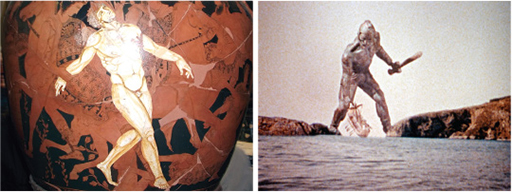1.1 Robotic servants
Writing perhaps eight hundred years before the birth of Christ, the Greek bard Homer, in the Iliad XVIII, tells of how:
Huge god Hephaestus got up from the anvil block
with laboured breathing...
At once he was helped along
by female servants made of gold, who moved to him.
They look like living servant girls, possessing minds,
hearts with intelligence, vocal chords, and strength.
They learned to work from the immortal gods.
Hephaestus himself had built these robotic servants. He also created Talos (Figure 2), a gigantic mechanical man of bronze, the guardian of Crete, who ran round the entire coast of the island three times a day (this equates to a speed of 250 miles per hour!) and hurled great rocks at suspected intruders.
Note that a persistent theme in conceptualisations of such artificial creatures is that they are somehow dual in nature: they are machine-like in that they are designed and built from materials ready-to-hand, and thus, similar to tools. Yet, they are also somehow human-like, imbued with mental qualities comparable to those of humans. While such beings may be designed and made by other, superhuman beings (e.g. Homeric gods), they are also to some extent autonomous, and exhibit some form of intelligence. As Mayor (2018) has recently put it, for the Greeks and other ancient societies, such creatures were understood as being ‘made, not born’. Mayor takes a broad view on such stories, considering them as part of the wider social and cultural context around technology, and indeed they point to a fascination with what Mayor terms ‘biotechne’ (i.e. ’life through craft’).
By comparison, AI technology is also arguably a designed ‘tool’, which can perform certain kinds of fairly simple sub-tasks within larger, more complex tasks normally carried out by humans. For example, consider the relatively complex task of calling up a company to make a complaint, where a chatbot might be the first point of online contact you make with the company, and it may have been designed to make the relatively straightforward decision about which department to redirect your query to. Thus, the chatbot essentially does a simple sub-task which a human would have had to carry out in the past, thereby arguably freeing up people for much more interesting and challenging pursuits. Of course, such technology is still in its infancy, and things can and often do go wrong – the chatbot may well end up connecting you to the wrong person.

